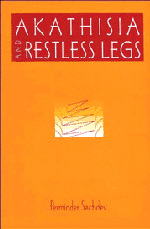Book contents
- Frontmatter
- Contents
- Foreword
- Acknowledgements
- Abbreviations
- Part I Introduction
- Part II Drug-induced akathisia
- 4 The definition of drug-induced akathisia
- 5 Epidemiology
- 6 Clinical characteristics and diagnosis of acute akathisia
- 7 Clinical characteristics of tardive and chronic akathisia
- 8 Akathisia due to a general medical condition
- 9 Assessment and measurement of akathisia
- 10 Aetiology and pathogenesis of akathisia
- 11 Treatment of drug-induced akathisia
- Part III Restless legs syndrome
- Part IV Conclusions
- Appendix A Haskovec's Akathisie
- Appendix B Prince Henry Hospital Akathisia Scale
- Appendix C Barnes (1989) Akathisia Rating Scale
- Appendix D Hillside Akathisia Scale (version 4)
- References
- Index
6 - Clinical characteristics and diagnosis of acute akathisia
from Part II - Drug-induced akathisia
Published online by Cambridge University Press: 12 September 2009
- Frontmatter
- Contents
- Foreword
- Acknowledgements
- Abbreviations
- Part I Introduction
- Part II Drug-induced akathisia
- 4 The definition of drug-induced akathisia
- 5 Epidemiology
- 6 Clinical characteristics and diagnosis of acute akathisia
- 7 Clinical characteristics of tardive and chronic akathisia
- 8 Akathisia due to a general medical condition
- 9 Assessment and measurement of akathisia
- 10 Aetiology and pathogenesis of akathisia
- 11 Treatment of drug-induced akathisia
- Part III Restless legs syndrome
- Part IV Conclusions
- Appendix A Haskovec's Akathisie
- Appendix B Prince Henry Hospital Akathisia Scale
- Appendix C Barnes (1989) Akathisia Rating Scale
- Appendix D Hillside Akathisia Scale (version 4)
- References
- Index
Summary
It is well recognized that even experienced psychiatrists can make errors in the diagnosis of akathisia. This is because the diagnosis is primarily clinical and no laboratory indices are available. While some clinical features are distinctive, none is pathognomonic, and considerable overlap occurs with restlessness due to other causes. Many case descriptions of akathisia have been published, but few studies have systematically examined the clinical features, and even these suffer from the lack of specific diagnostic criteria and subtyping, as discussed previously.
In this book the clinical features of AA and TA are discussed separately. This separation reflects the view that the two syndromes can be distinguished by pathophysiology, longitudinal course and pharmacological profile. WA is described in association with TA for two reasons: Its clinical descriptions are few and do not produce a distinctive picture, and a parallel exists in the TD literature in which withdrawal dyskinesia is described as a subsyndrome of TD (Schooler and Kane, 1982).
Demographic factors
Age
The relationship between age and AA has not been adequately examined. Ayd (1961) suggested that akathisia was most prevalent between ages 12 and 65 years in his sample, in distinction with dystonia (more likely in the young) and parkinsonism (more likely in the elderly). The oldest person with akathisia in this series was 64, even though a significant number of subjects (not stated) were in their seventies and eighties.
- Type
- Chapter
- Information
- Akathisia and Restless Legs , pp. 118 - 151Publisher: Cambridge University PressPrint publication year: 1995



